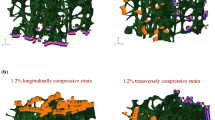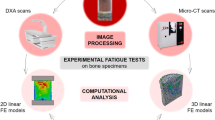Abstract
The in-vivo micro-structure and corresponding material property of trabecular bone is important to simulate the mechanical behavior of macroscopic bone structure. In order to simulate the mechanical behavior of bone numerically, the apparent Young’s modulus of trabecular bone should be available. Generally a high-resolution finite-element model based on micro-CT-images could be was used to estimate this value. However, all the previous works regarding this issue have employed either eight-noded voxel elements or four-noded tetrahedral elements, which usually produces large amount of error in estimating an apparent material property. Therefore, rigorous studies on the accuracy of element type for predicting the material properties of cancellous bone have been made in this paper. Micro-CT-data were extracted from a femoral neck to construct three-dimensional finite-element models with three different element types and compression analyses were performed numerically (up to 1.3% strain) to estimate the apparent modulus. Compression tests using the specimens extracted from a cadaver were also performed to validate the simulated apparent material properties using different element types. As a result, ten-noded tetrahedral elements are recommended to obtain reliable material properties of cancellous bone instead of eight-noded voxel elements or four-noded tetrahedral elements.
Similar content being viewed by others
References
Ray, N. F., Chan, J. K., Thamer, M., and Melton Iii, L. J., “Medical expenditures for the treatment of osteoporotic fractures in the United States in 1995: Report from the National Osteoporosis Foundation,” Journal of Bone and Mineral Research, Vol. 12, No. 1, pp. 24–35, 1997.
Praemer, A., Furner, S., and Rice, D. P., “Musculoskeletal conditions in the United States,” American Academy of Orthopaedic Surgeons, 1992.
Zioupos, P. and Currey, J. D., “Changes in the stiffness, strength, and toughness of human cortical bone with age,” Bone, Vol. 22, No. 1, pp. 57–66, 1998.
Ding, M., Dalstra, M., Danielsen, C. C., Kabel, J., Hvid, I., and Linde, F., “Age variations in the properties of human tibial trabecular bone,” Journal of Bone and Joint Surgery — Series B, Vol. 79, No. 6, pp. 995–1002, 1997.
Ruegsegger, P., Koller, B., and Muller, R., “A microtomographic system for the nondestructive evaluation of bone architecture,” Calcified Tissue International, Vol. 58, No. 1, pp. 24–29, 1996.
Hipp, J. A., Jansujwicz, A., Simmons, C. A., and Snyder, B. D., “Trabecular bone morphology from micro-magnetic resonance imaging,” Journal of Bone and Mineral Research, Vol. 11, No. 2, pp. 286–292, 1996.
Hollister, S. J., Fyhrie, D. P., Jepsen, K. J., and Goldstein, S. A., “Application of homogenization theory to the study of trabecular bone mechanics,” Journal of Biomechanics, Vol. 24, No. 9, pp. 825–839, 1991.
Hollister, S. J., “A homogenization sampling procedure for calculating trabecular bone effective stiffness and tissue level stress,” Journal of Biomechanics, Vol. 27, No. 4, pp. 433–444, 1994.
Hollister, S. J., Kikuchi, N., and Goldstein, S. A., “Do bone ingrowth processes produce a globally optimized structure?” Journal of Biomechanics, Vol. 26, No. 4–5, pp. 391–407, 1993.
Müller, R. and Rüegsegger, P., “Analysis of mechanical properties of cancellous bone under conditions of simulated bone atrophy,” Journal of Biomechanics, Vol. 29, No. 8, pp. 1053–1060, 1996.
Van Rietbergen, B., Weinans, H., and Huiskes, R., “Prospects of computer models for the prediction of osteoporotic bone fracture risk,” Studies in health technology and informatics, Vol. 40, No. pp. 25–32, 1997.
Van Rietbergen, B., Odgaard, A., Kabel, J., and Huiskes, R., “Relationships between bone morphology and bone elastic properties can be accurately quantified using high-resolution computer reconstructions,” Journal of Orthopaedic Research, Vol. 16, No. 1, pp. 23–28, 1998.
Niebur, G. L., Feldstein, M. J., Yuen, J. C., Chen, T. J., and Keaveny, T. M., “High-resolution finite element models with tissue strength asymmetry accurately predict failure of trabecular bone,” Journal of Biomechanics, Vol. 33, No. 12, pp. 1575–1583, 2000.
Ladd, A. J. C., Kinney, J. H., Haupt, D. L., and Goldstein, S. A., “Finite-element modeling of trabecular bone: Comparison with mechanical testing and determination of tissue modulus,” Journal of Orthopaedic Research, Vol. 16, No. 5, pp. 622–628, 1998.
Hou, F. J., Lang, S. M., Hoshaw, S. J., Reimann, D. A., and Fyhrie, D. P., “Human vertebral body apparent and hard tissue stiffness,” Journal of Biomechanics, Vol. 31, No. 11, pp. 1009–1015, 1998.
Chae, S. W., Lee, M. K., Park, J. Y., Lee, T. S., and Park, S. B., “Finite element analysis and the clinical consideration for the methodology of PMMA injection in vertebroplasty,” Int. J. Precis. Eng. Manuf., Vol. 13, No. 8, pp. 1467–1472, 2012.
Kim, H. J., Chu, J. U., Han, S. M., Choi, K. W., Yoo, J. H., and Youn, I. C., “Study of optimized hip implant development for hip implant in total hip replacement,” Int. J. Precis. Eng. Manuf., Vol. 12, No. 4, pp. 719–725, 2011.
Kabel, J., Van Rietbergen, B., Dalstra, M., Odgaard, A., and Huiskes, R., “The role of an effective isotropic tissue modulus in the elastic properties of cancellous bone,” Journal of Biomechanics, Vol. 32, No. 7, pp. 673–680, 1999.
Bayraktar, H. H., Morgan, E. F., Niebur, G. L., Morris, G. E., Wong, E. K., and Keaveny, T. M., “Comparison of the elastic and yield properties of human femoral trabecular and cortical bone tissue,” Journal of Biomechanics, Vol. 37, No. 1, pp. 27–35, 2004.
McNamara, L. M., Van Der Linden, J. C., Weinans, H., and Prendergast, P. J., “Stress-concentrating effect of resorption lacunae in trabecular bone,” Journal of Biomechanics, Vol. 39, No. 4, pp. 734–741, 2006.
Saxena, R., Kellers, T. S., and Sullivan, J. M., “A three-dimensional finite element scheme to investigate the apparent mechanical properties of trabecular bone,” Computer Methods in Biomechanics and Biomedical Engineering, Vol. 2, No. 4, pp. 285–294, 1999.
Jaecques, S. V. N., Van Oosterwyck, H., Muraru, L., Van Cleynenbreugel, T., De Smet, E., Wevers, M., Naert, I., and Vander Sloten, J., “Individualised, micro CT-based finite element modelling as a tool for biomechanical analysis related to tissue engineering of bone,” Biomaterials, Vol. 25, No. 9, pp. 1683–1696, 2004.
Morgan, E. F. and Keaveny, T. M., “Dependence of yield strain of human trabecular bone on anatomic site,” Journal of Biomechanics, Vol. 34, No. 5, pp. 569–577, 2001.
Author information
Authors and Affiliations
Corresponding author
Rights and permissions
About this article
Cite this article
Park, S., Chae, SW., Park, J. et al. Finite element modeling to estimate the apparent material properties of trabecular bone. Int. J. Precis. Eng. Manuf. 14, 1479–1485 (2013). https://doi.org/10.1007/s12541-013-0199-3
Received:
Accepted:
Published:
Issue Date:
DOI: https://doi.org/10.1007/s12541-013-0199-3




